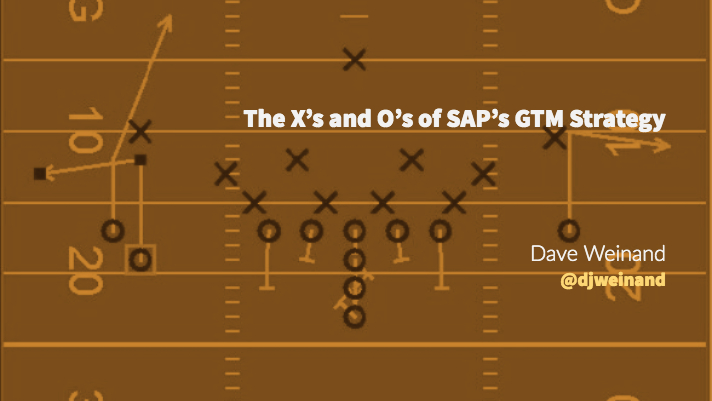At this week’s SAP Analyst Base Camp, SAP profiled a continuing evolution of their journey to enable their customers to keep up with a dramatically new digital business environment.

As the dog days of summer hit their stride, a group of 75 or so industry analysts converged on the N. American headquarters of SAP to hear about their industry go-to-market strategies. It was a whirlwind of information that was condensed into both cross-industry and industry-specific tracks.
From a messaging perspective, it was actually refreshing to hear that they are remaining consistent with their ‘Intelligent Enterprise’ go-to-market message from 2017 and 2018, and avoiding the technology vendor trap of jumping on the latest buzzword messaging go to market.
Fortunately, the ‘Intelligent Enterprise’ go to market messaging is more than just a marketing play. They have built their entire industry solution portfolio behind the concept of enabling their customers to leverage better processes and better data to, in fact, become more Intelligent. Where the messaging has evolved, however, is that the Intelligent Enterprise is enabling companies to deliver on the ‘Experience Economy’. A little buzzwordy, but they can have a pass on this one.
SAP has made its share of strategic acquisitions over the years, but I don’t recall any being integrated as tightly into their broad industry strategy as the Qualtrics acquisition. While SAP has built its reputation for managing operational processes and data (e.g. supply chain, people, finance, merchandising) and delivering insights from that data, they are using the Qualtrics platform to integrate customer, product, employee and brand data (e.g. more sentiment & experience related data) to provide a holistic digital platform that can deliver better business value. The experience related data is being called the ‘X Data’ while the operational data is called the “O data’. These X’s and O’s are what is driving their solutions and offerings.
In addition, as businesses across industries struggle with how to most effectively take advantage of new technologies such as AI/ML, Predictive Analytics, Robotics, or IoT, SAP has taken the step of developing what they call ‘Intelligent Technologies Packages’ to apply to specific use cases in order to accelerate the exposure and value of these technologies.
The Retail Suite
While we covered what was likely 8 hours of solution overviews and solution positioning in about 3.5, some exciting highlights were gleaned as SAP continues to evolve its retail portfolio.
- Intelligent Suite - These are essentially cross-application microservices (they call them business services) that have been developed to leverage data from both the C/4 HANA & S/4 HANA suites. Some will be embedded into the C/4 & S/4 HANA suites, some will be add-on services, but they include services such as asset management, business partner management, offer management and MDM.
- Consumer Sales Intelligence - One of the clear messages heard at the event was that SAP is seeing the importance of working more collaboratively with partners as well as providing ways for customers to better leverage the data they get from SAP solutions to share with other partners. The result is that SAP has developed a microservice inside of their Customer Activity Repository (CAR) to be able to more effectively pull data out to share with partners and suppliers.
- Dynamic Pricing - Continuing with their longtime strategic partner GK Software, SAP is offering their Dynamic Pricing by GK solution inside of CAR. While not a full-blown price optimization solution, it offers the ability for SAP customers to manage base price and markdown in close to real-time to make quick adjustments on the fly if needed.
- Analytics Cloud - This has been a solution that has been in development for several years (and has been much needed). It is designed to provide prescriptive analytics tools that are integrated into the solution stack. Like the Qualtrics experience management suite, it sits as a separate layer in the solution stack, but it is designed to be multi-tenant and adapt to the infrastructure in place at the retailer.
- Evolution of the Planning Suite - As retailers continue to evolve their business models to adapt to consumer preferences, it requires an evolution of how planning systems must operate. SAP understands this and has built a roadmap for a more comprehensive suite that leverages the ‘X’ and the ‘O’ data sets for more accurate planning and forecasting. They are also incorporating machine learning into the solution to enable customers to incorporate product attributes to predict suitable recommendations or substitutions for products and provide analysis to avoid product cannibalization.
They highlighted a customer, Swiss conglomerate COOP, that is leveraging their forecasting and replenishment (F&R) and unified demand forecast (UDF) solution to significantly improve their allocation (and therefore, reduce waste) of goods across their widely varying store portfolio. - Cloud strategy - For the ultimate on-prem ERP vendor, transitioning to cloud-based offerings is not an overnight activity. However, they detailed a clear roadmap of how and where their customers can take advantage of cloud-based solutions based on preference. Across the portfolio, customers can choose between public or private clouds and can determine the level of management and oversight internally vs. by SAP. The flexibility is a requirement in today’s environment.
- Experience Management - SAP’s offerings around experience management sit in the C/4 HANA stack. This is made up of five distinct solutions (Marketing, Commerce, Customer Data, Sales, Service), all sitting in unique cloud environments. To offer a more unified and easy way to use these platforms for multi-solution clients, SAP has launched what they call the Foundation. It connects the five disparate cloud-based C/4 services for a more harmonized user experience and a better way to integrate business and master data services.
In what I would probably call the most ‘German’ comment of the week, SAP’s global vice president of their retail business unit said, “A great experience is driven from process excellence’. This is, in fact, true and from what I saw and heard, SAP is making the right moves on the playing field with their ‘X’s and O’s.





